Once a majestic city in ancient Israel, Tirzah's biblical narratives of power and intrigue beckon to be explored further.
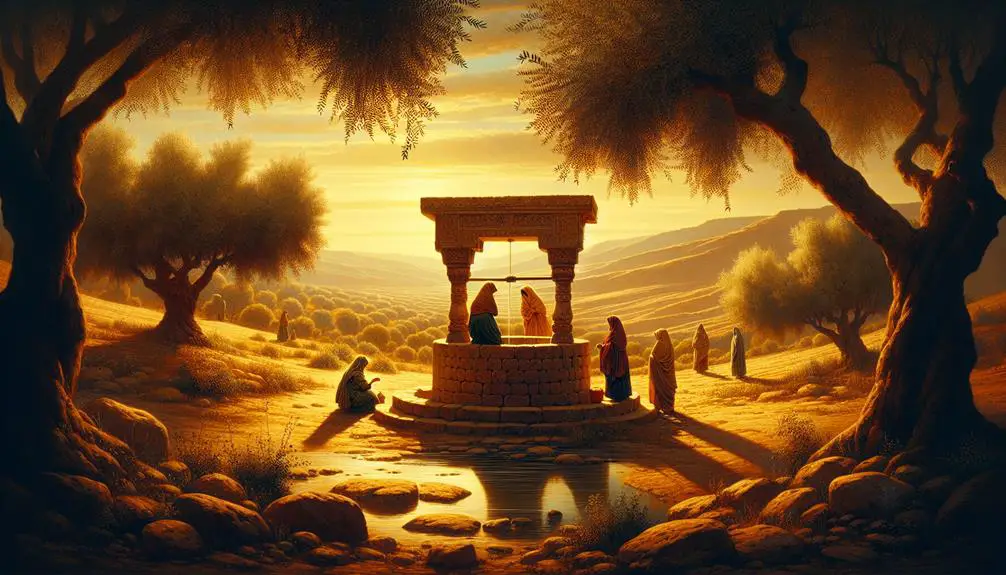
Tirzah in the Bible
Imagine wandering through the ancient, sunbaked landscapes of Canaan, where the city of Tirzah once stood, gleaming under the relentless Middle Eastern sun. As you explore its significance, you'll uncover that Tirzah wasn't just another name on the biblical map; it held a pivotal role in Israel's monarchy and its narrative in the Scriptures.
Its first mention, geographical significance, and the intriguing tales of power struggles and royal intrigue that unfolded within its boundaries provide a rich tapestry for discussion. However, what truly sets Tirzah apart, and why does its legacy endure in history?
Let's uncover the layers of this ancient city's story together.
Key Takeaways
- Tirzah served as a significant capital in Israel's monarchy before the establishment of Samaria.
- It was a site of royal importance, marked by its strategic location and architectural beauty.
- The city holds symbolic meanings in biblical narratives, often representing divine love and beauty.
- Tirzah's decline reflects lessons on political instability and economic shifts, paralleling modern historical contexts.
The First Mention of Tirzah
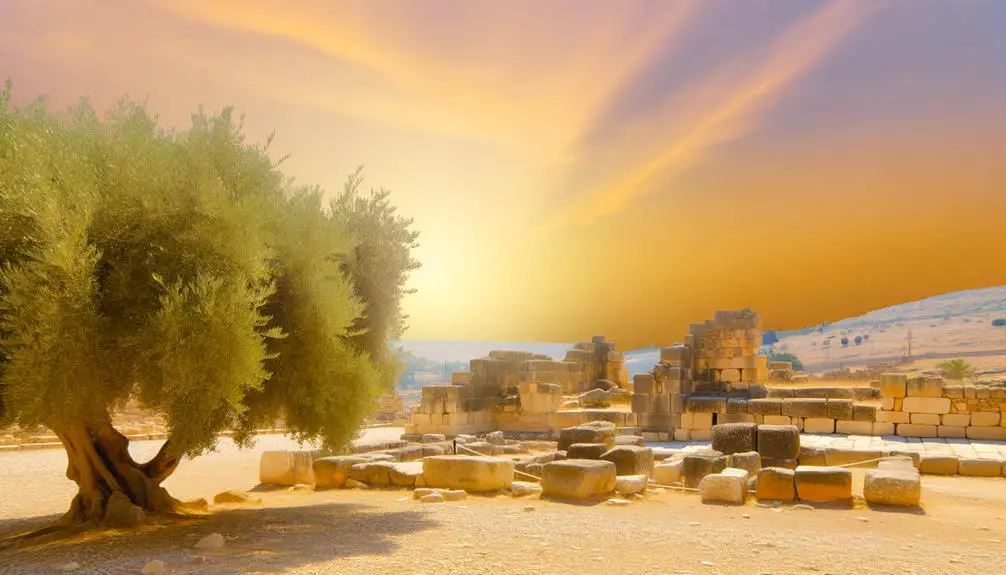
Tirzah first appears in the biblical narrative within the Book of Numbers, where it's mentioned as a significant location during the Israelites' wanderings. This early mention underscores its importance in the historical and spiritual landscape of the ancient Near East. As you delve deeper into the textual references and historical contexts, you'll find that Tirzah's beauty and its association with family lineage are themes that emerge with notable significance.
The term 'Tirzah,' besides being a place, is also used in the Song of Solomon, symbolizing beauty and desirability. This dual use of the term highlights not only the physical allure of the location but also imbues it with a deeper, metaphorical beauty. It's as if the narrative itself wants to emphasize the attractiveness of Tirzah, both as a physical space and in its inhabitants.
Furthermore, the mention of Tirzah in the context of family lineage can't be overlooked. In the biblical genealogies, connections to places often signify more than just geographical details; they suggest heritage, identity, and divine providence. Tirzah's linkage to significant familial lines within the scripture underscores this point, suggesting a place of both historical and spiritual lineage.
Analyzing these references, you'll appreciate how the biblical text weaves together themes of beauty and heritage, anchoring them in the physical and spiritual landscape of Tirzah. This not only enriches our understanding of the place itself but also offers insights into the broader narrative structures and thematic concerns of the biblical world.
Geography and Archaeology
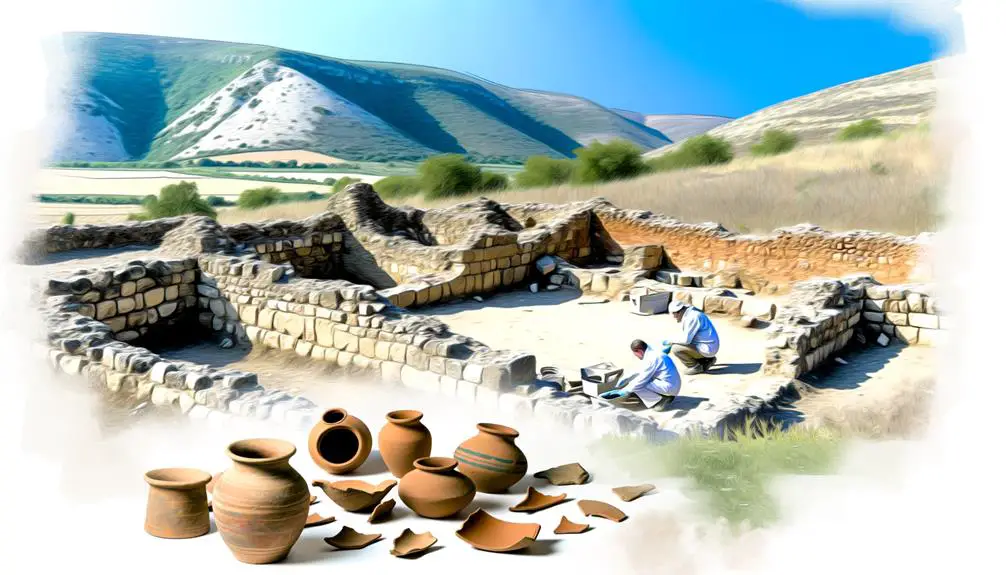
Exploring the geography and archaeology of the region sheds light on how the physical setting of Tirzah influenced its historical and scriptural significance. Nestled in a fertile valley with access to vital trade routes, Tirzah's strategic location played a pivotal role in its development and prominence in ancient times. The excavation findings have provided a wealth of information, revealing the city's layout, its fortifications, and the daily life of its inhabitants.
Key insights from archaeological studies include:
- Urban Structure: Excavations have uncovered evidence of a well-planned urban layout, suggesting a high degree of social organization and architectural knowledge.
- Economic Activities: Artifacts such as pottery, tools, and coins point to a vibrant economy, with agriculture, trade, and possibly local crafts playing significant roles.
- Religious Practices: Findings related to places of worship and religious artifacts offer glimpses into the spiritual life of Tirzah's residents, including their rituals and beliefs.
- Defensive Works: The discovery of walls and other defensive structures indicates Tirzah was a fortified city, reflecting its strategic importance and the need for protection against invaders.
These archaeological discoveries not only enhance our understanding of Tirzah's physical and social landscape but also draw modern parallels. Just as today's urban centers are shaped by geography and economy, so was Tirzah. By examining the past, we gain insights into the universal factors that influence the rise and fall of cities, drawing a link between ancient times and our current urban experiences.
Tirzah in Israel's Monarchy
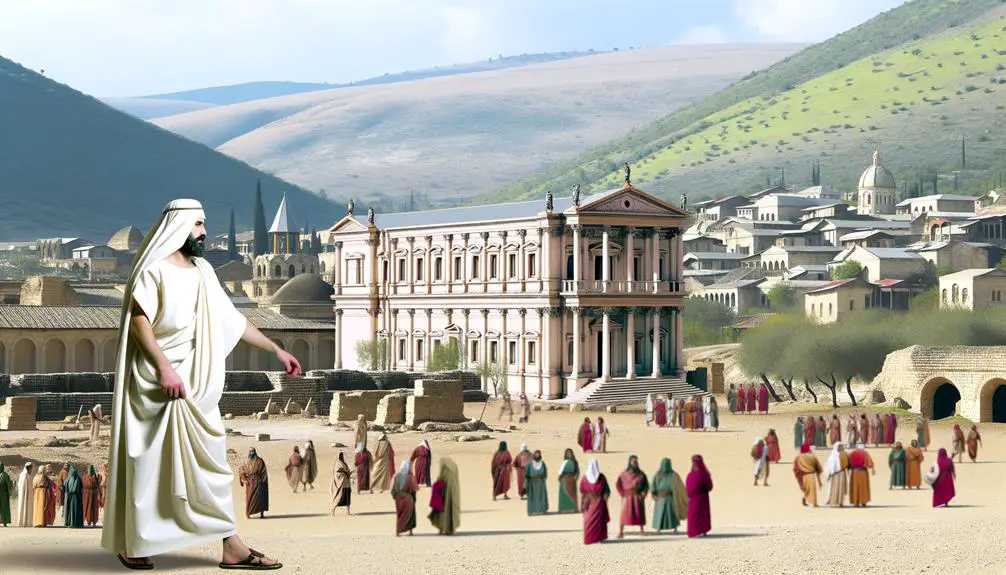
You'll find that Tirzah holds significant weight in the narrative of Israel's monarchy, serving as a preeminent capital before the establishment of Samaria.
This transition underscores the city's pivotal role during a period marked by the monarchy's expansion and subsequent decline.
Analyzing Tirzah's royal significance offers insights into the socio-political dynamics of ancient Israel during this transformative era.
Tirzah's Royal Significance
Delving into the annals of Israel's monarchy, one can't overlook the pivotal role that Tirzah played as a royal city. Its significance is underscored by:
- The frequent biblical references to Tirzah's beauty, suggesting a city of great splendor and importance.
- Historical accounts that highlight its role in the political and social landscape of Israel.
- Archaeological findings, including architectural remnants, that provide tangible proof of its royal status.
- The strategic location of Tirzah, which bolstered its function as a center of power and governance.
These facets collectively underscore Tirzah's critical role within Israel's monarchy. Its beauty, coupled with the archaeological evidence, paints a picture of a city that wasn't only aesthetically pleasing but also of great royal significance.
Capital Before Samaria
Building on its royal significance, it's essential to recognize Tirzah as the initial capital of Israel's monarchy before the emergence of Samaria. This transition underscores a pivotal moment in the nation's history, as archaeological methods have unveiled. By comparing findings from Tirzah and modern Samaria, scholars gain insights into the socio-political and cultural shifts within ancient Israel.
Aspect |
Tirzah vs. Modern Samaria |
|---|---|
Political Status |
Initial capital |
Cultural Impact |
Foundational era |
Archaeological |
Rich in historical layers |
Transition |
To Samaria as capital |
This comparison not only highlights Tirzah's importance but also showcases the evolving nature of Israel's monarchy, guided by advancements in archaeological methods.
Monarchy's Decline Era
As the monarchy in Israel waned, Tirzah's role within it underwent significant transformations, reflecting broader socio-political shifts. This era was marked by economic reforms that reshaped the financial landscape, religious shifts that challenged traditional worship practices, a decline in central authority allowing regional powers to rise, and social upheavals as a result of these changes.
These elements collectively contributed to the changing status of Tirzah in the waning years of Israel's monarchy. The city, once a significant political and religious hub, found its prominence affected by these widespread transformations. The economic reforms and religious shifts, in particular, played critical roles in altering the social fabric of Tirzah, contributing to its evolution from a vibrant royal city to a historical footnote in the narrative of Israel's monarchy.
Biblical References and Interpretations
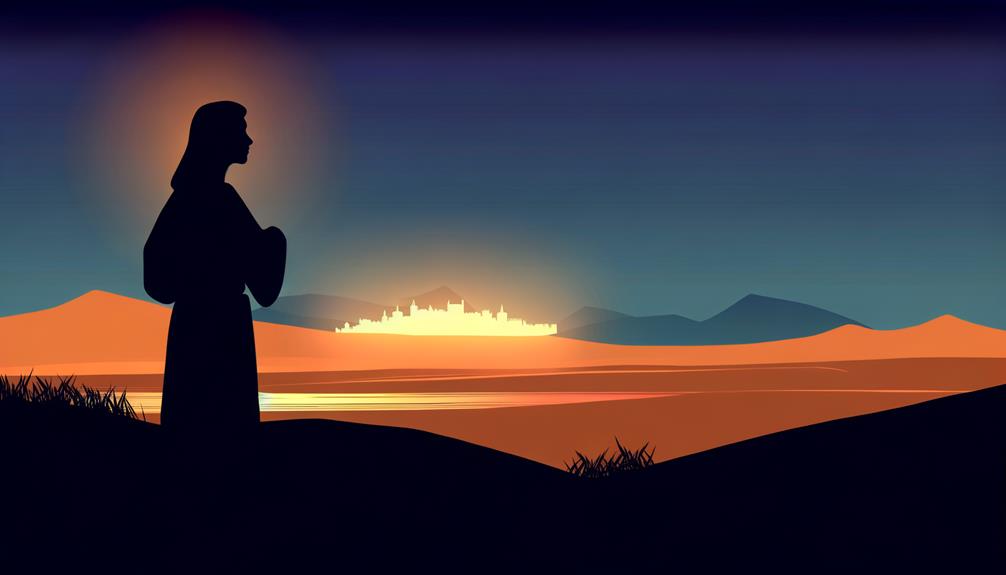
You'll find that Tirzah's appearances in scripture aren't merely historical footnotes but are imbued with profound symbolic significance. Each mention offers insights into its historical context, revealing layers of meaning that scholars have sought to interpret over centuries.
This analysis will guide you through the scriptural mentions, explore the symbolic meanings, and contextualize Tirzah within its historical framework.
Tirzah's Scriptural Mentions
Within the canon of Scripture, Tirzah is mentioned several times, offering insight into its historical and theological significance. You'll find Tirzah intriguing not just for its mentions but also for the layers of meaning these references entail, particularly concerning Tirzah's beauty and family connections.
- Tirzah's beauty is metaphorically noted, suggesting a deeper significance beyond mere physical attractiveness.
- Family connections of Tirzah are highlighted, underscoring its importance in lineage and heritage narratives.
Its strategic and historical role within the territorial divisions of Israel is documented, providing context to its significance. References to Tirzah in poetic and prophetic books offer insights into its symbolic value within the broader scriptural narrative.
This analysis shows Tirzah as more than a mere location, revealing its multifaceted role in biblical history and theology.
Symbolic Meanings Explored
Exploring the symbolic meanings of Tirzah in the Bible reveals layers of interpretation that enhance our understanding of its textual and theological significance.
The name Tirzah itself, often enveloped in poetic imagery within the scriptures, serves as a potent love metaphor. This metaphorical usage underscores not only the beauty and desirability attributed to Tirzah but also its representation of divine love and favor.
The employment of Tirzah in such a manner reflects a nuanced approach to conveying spiritual truths, where the physical allure of Tirzah is emblematic of deeper, heavenly affections. Through this lens, the biblical references to Tirzah transcend their historical specificity, inviting readers to contemplate the nature of divine love and the ways it's manifested and recognized in the world.
Tirzah's Historical Context
Delving into Tirzah's historical context within the Bible, we uncover a rich tapestry of interpretations that reveal its multifaceted significance in ancient narratives. This exploration allows us to appreciate its role beyond just a geographical location, highlighting its cultural and historical layers.
- The cultural significance of Tirzah is illuminated through its repeated mentions, suggesting a place of beauty and desire.
- Architectural styles found in archaeological digs near Tirzah provide insights into the craftsmanship and aesthetic preferences of its inhabitants.
- Biblical references position Tirzah as a center of power and governance, reflecting its political importance.
- The city's strategic location contributes to our understanding of ancient trade routes and military tactics.
Analyzing Tirzah's historical context deepens our appreciation for its role in shaping the cultural and political landscape of the Bible.
The Decline of Tirzah
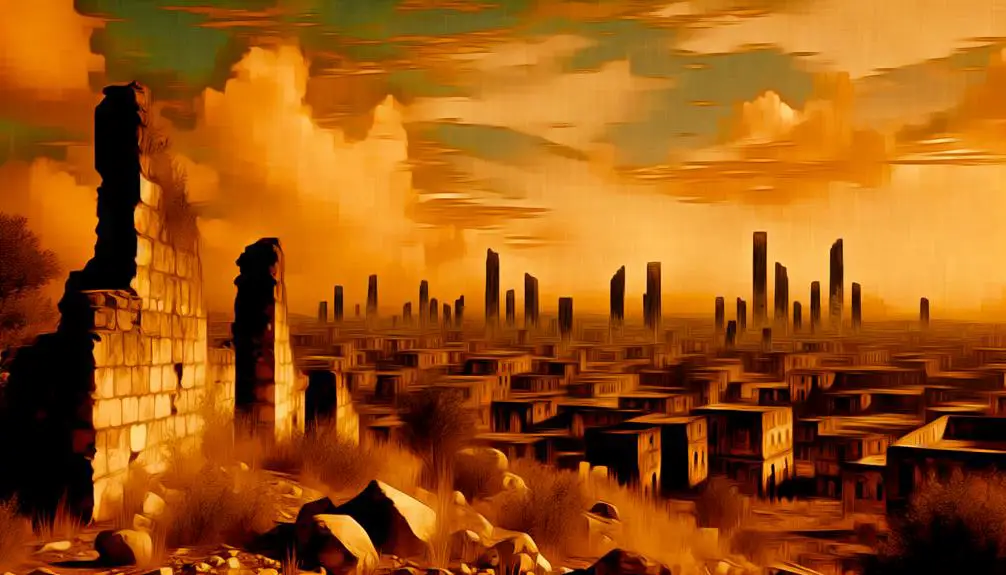
Despite its initial prominence in ancient texts, Tirzah experienced a significant decline due to a combination of political instability and external threats. The city, once celebrated for its beauty, faced challenges that gradually eroded its status and significance in the region. This decline can be understood through an examination of key factors that contributed to its downfall.
Factor |
Impact |
Modern Parallels |
|---|---|---|
Political Instability |
Weakened governance and internal conflicts |
Similar to modern cities facing political upheavals |
External Threats |
Invasions and pressures from neighboring entities |
Comparable to modern geopolitical tensions affecting cities |
Economic Decline |
Reduction in trade and economic activities |
Echoes in modern cities experiencing economic downturns |
Loss of Strategic Importance |
Shift in trade routes and political alliances |
Analogous to modern cities losing their geostrategic value |
Tirzah's beauty, once a source of pride and an emblem of its prosperity, could not shield it from the harsh realities of political and military strife. The city's decline serves as a poignant reminder of the transient nature of power and prominence. Modern parallels can be drawn to cities around the world that have experienced similar fates due to comparable dynamics of political instability, external threats, economic downturns, and shifts in strategic significance. The story of Tirzah underscores the importance of stability, strategic foresight, and resilience in maintaining a city's status and well-being.
Tirzah's Legacy in History
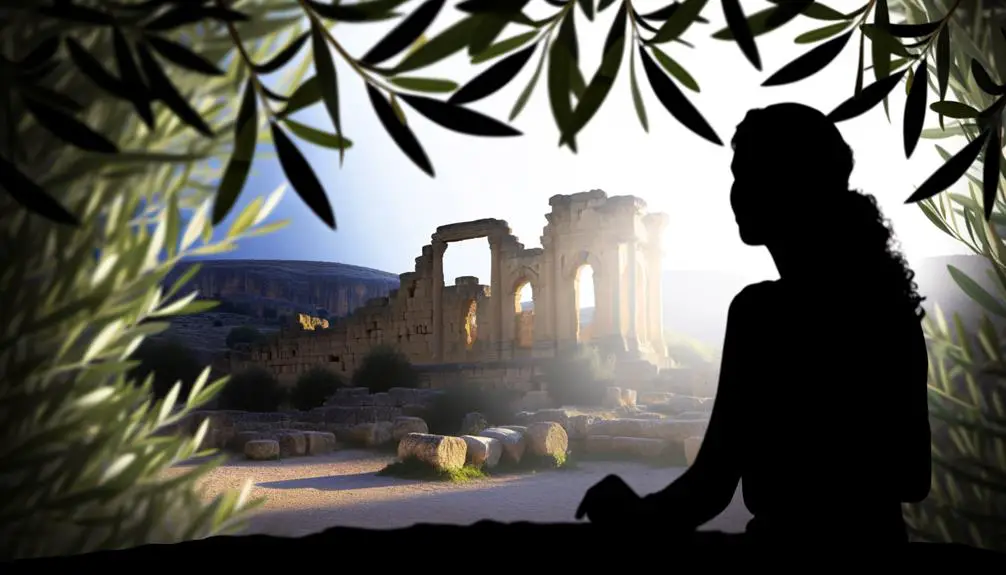
How does Tirzah's enduring legacy, amidst its historical decline, continue to influence our understanding of ancient cities and their trajectories? Despite its fading from prominence, Tirzah's remnants offer a window into the architectural and cultural dynamics of ancient Semitic civilizations. Its legacy, though not always highlighted in mainstream historical narratives, contributes significantly to our comprehension of urban development, societal structures, and cultural evolution in the ancient Near East.
- Tirzah's architecture provides critical insights into the urban planning and construction techniques of its time. The city's layout, building materials, and structural innovations reveal much about the priorities, technologies, and aesthetic values of its inhabitants.
- The cultural influence of Tirzah extends beyond its physical boundaries. As a once-thriving city-state, it played a role in the intricate web of diplomatic, trade, and cultural exchanges that characterized the ancient Near East, influencing and being influenced by neighboring polities.
- Archaeological findings from Tirzah have contributed to a richer understanding of the socio-political and religious practices that shaped life in ancient Semitic cities. These discoveries provide tangible links to the past, allowing scholars to piece together the complexities of ancient societies.
- Lastly, Tirzah's history as documented in biblical and extrabiblical sources offers a unique perspective on the interplay between historical events and religious narratives, shedding light on how ancient communities understood their world and their place within it.
Tirzah's legacy, therefore, enriches our understanding of the ancient world, offering lessons on the resilience, adaptability, and cultural vibrancy of cities that once dotted the ancient Near Eastern landscape.
Frequently Asked Questions
How Has the Story of Tirzah Influenced Modern Literature and Art?
You're exploring how the story of Tirzah has seeped into modern literature and art, focusing on its geography and literary motifs.
This tale, even stripped of its biblical roots, offers a rich tapestry for analysis. Its geographical setting provides a lush backdrop, inspiring vivid descriptions in narratives.
Literary motifs drawn from Tirzah's story, such as quests for justice and inheritance rights, have resonated deeply, influencing character developments and themes in contemporary works.
Are There Any Contemporary Religious or Cultural Practices That Can Be Traced Back to Tirzah's Significance in Ancient Times?
Can you imagine how ancient places shape today's rituals?
While there's no direct link between contemporary religious or cultural practices and Tirzah's ancient significance, the geography of modern Tirzah still whispers its historical weight.
Scholars haven't pinpointed practices originating specifically from Tirzah, yet its historical presence subtly influences regional culture.
This absence of a direct lineage doesn't diminish Tirzah's importance but rather highlights the complex layers of cultural evolution over millennia.
Has Tirzah Been Represented in Any Notable Films, Plays, or Musical Compositions?
You're likely curious if Tirzah has made her way into film adaptations or stage portrayals, given her intriguing story.
While specific references to her in major cinematic or theatrical works are scarce, the essence of her narrative may have influenced various creative projects indirectly.
Analyzing these adaptations requires a keen eye for thematic parallels and character inspirations, as direct acknowledgments of her story in mainstream arts remain relatively unexplored.
What Are the Psychological or Symbolic Interpretations of Tirzah's Role and Mentions in Biblical Narratives?
You might find the symbolic significance of cities and female figures in ancient texts intriguing. City symbolism often represents protection, power, and community, while the feminine archetype can symbolize creation, nurturing, and destruction.
Analyzing these elements in historical narratives offers deep psychological insights. Specifically, considering Tirzah's mentions, you see a blend of these symbols, reflecting complex societal and personal dynamics.
This approach unveils layers of meaning in seemingly straightforward stories.
How Do Different Religious Denominations Today View or Interpret the Historical and Biblical Accounts of Tirzah?
You're looking at how different religious groups today understand historical and biblical narratives, focusing on archaeological evidence and geographical significance. It's fascinating to see the variety in interpretations.
Some lean heavily on archaeological findings to confirm or question traditional views, while others emphasize the spiritual or symbolic meanings, intertwining them with the geographical backdrop.
This analytical approach reveals a rich tapestry of beliefs and understandings that continue to evolve with ongoing research and discoveries.
Conclusion
In the tapestry of biblical history, Tirzah stands as a faded thread, its once vibrant colors dulled by the passage of time. You've wandered through its ancient streets, traced the contours of its storied past, and examined the pivotal role it played in Israel's monarchy.
Yet, as empires rose and fell, Tirzah slipped into the shadows, its legacy a whisper in the annals of history. This journey reveals not just the physical decline of a city but the transient nature of power and glory.

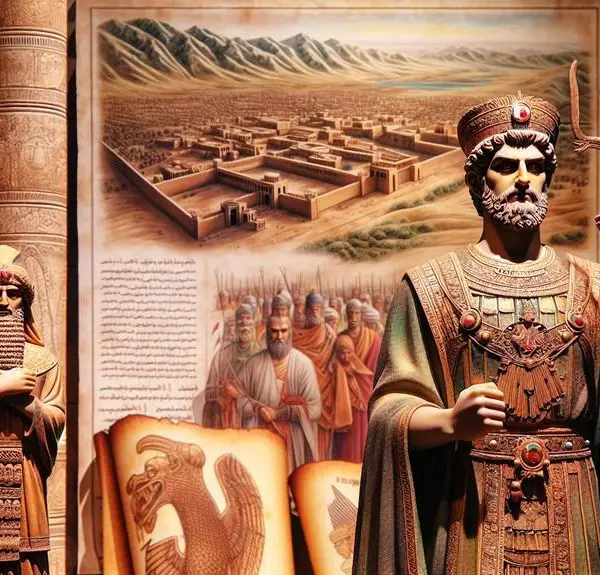
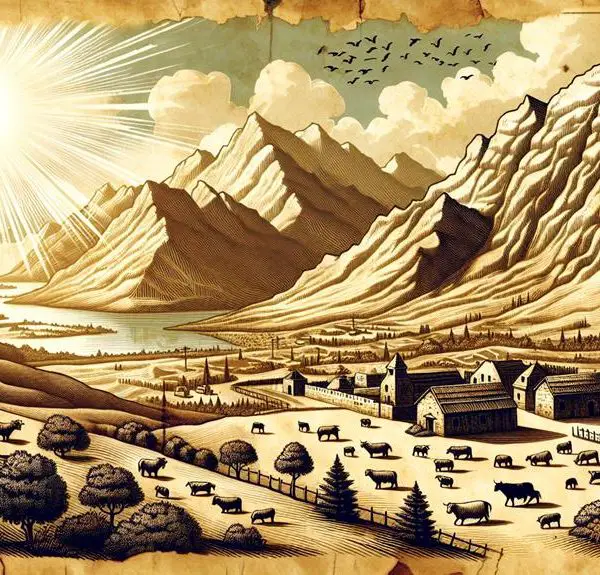
Sign up